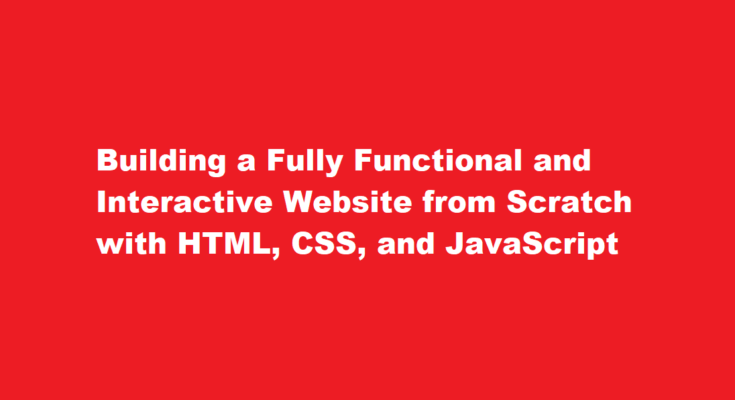In today’s digital age, having a strong online presence is essential, whether you’re a business owner, a creative professional, or simply looking to share your passion with the world. Building a website from scratch might seem like a daunting task, but with the right guidance and a bit of patience, you can create a fully functional and interactive website using HTML, CSS, and JavaScript. In this article, we’ll take you through the essential steps to help you get started on your web development journey.
Planning and Design
Before you dive into coding, it’s crucial to plan your website’s structure and design. Consider your website’s purpose, target audience, and the content you want to showcase. Sketch out a rough layout, including the navigation menu, headers, and content sections. This planning phase will serve as your roadmap throughout the development process.
HTML – Building the Structure
HTML (Hypertext Markup Language) is the foundation of any web page. It defines the structure and content of your website. Start by creating an HTML document and setting up the basic structure, including the `<html>`, `<head>`, and `<body>` tags. Use semantic HTML elements like `<header>`, `<nav>`, `<main>`, `<article>`, and `<footer>` to structure your content logically.
Here’s a basic HTML template to get you started
“`html
<!DOCTYPE html>
<html lang=”en”>
<head>
<meta charset=”UTF-8″>
<meta name=”viewport” content=”width=device-width, initial-scale=1.0″>
<title>Your Website Title</title>
<link rel=”stylesheet” href=”styles.css”>
</head>
<body>
<header>
<!– Your website header content goes here –>
</header>
<nav>
<!– Navigation menu goes here –>
</nav>
<main>
<!– Main content of your website –>
</main>
<footer>
<!– Footer content goes here –>
</footer>
</body>
</html>
“`
CSS – Styling Your Website
CSS (Cascading Style Sheets) allows you to style and format your website. Create a separate CSS file (styles.css) and link it to your HTML document. Use CSS to control fonts, colors, layout, and other visual aspects of your website.
Here’s an example of how to style a header
“`css
/* styles.css */
header {
background-colour: #333;
colour: #fff;
padding: 20px;
text-align: centre;
}
“`
Experiment with different CSS properties to achieve the desired look and feel for your website.
JavaScript – Adding Interactivity
JavaScript is a powerful programming language that enables you to add interactivity to your website. You can use it to create dynamic elements, handle user input, and make your website more engaging.
For example, if you want to create a simple image slideshow, you can use JavaScript
“`html
<!– HTML –>
<div id=”slideshow”>
<img src=”image1.jpg” alt=”Image 1″>
<img src=”image2.jpg” alt=”Image 2″>
<img src=”image3.jpg” alt=”Image 3″>
</div>
“`
“`javascript
// JavaScript
const slideshow = document.getElementById(‘slideshow’);
const images = slideshow.getElementsByTagName(‘img’);
let currentImageIndex = 0;
function changeImage() {
images[currentImageIndex].style.display = ‘none’;
currentImageIndex = (currentImageIndex + 1) % images.length;
images[currentImageIndex].style.display = ‘block’;
}
setInterval(changeImage, 3000); // Change image every 3 seconds
“`
This code will create a simple image slideshow that automatically transitions between images every three seconds.
Testing and Debugging
Testing your website across different browsers and devices is crucial to ensure it works as expected. Use browser developer tools to debug and fix any issues. Validate your HTML and CSS code to ensure it follows best practices.
Hosting Your Website
To make your website accessible on the internet, you’ll need web hosting. There are various hosting providers available, and some even offer free hosting options. Choose a hosting provider, upload your HTML, CSS, and JavaScript files, and configure your domain name (if you have one).
Continuous Improvement
A website is never truly finished. Continuously update and improve your site based on user feedback and changing requirements. Stay up to date with web development trends and technologies to keep your site modern and relevant.
FREQUENTLY ASKED QUESTIONS
Can we make a complete website using HTML CSS and JavaScript?
Yes, it is possible to create a website using only HTML, CSS, and JavaScript. These three technologies are the cornerstone of the modern web and are essential for creating dynamic, interactive websites. HTML is used to structure the content of a webpage, including text, images, and other media.
How many days are required to learn HTML CSS and JavaScript?
If you want to completely learn these languages from basics to advance then you should have to spend 2 hours a day and you will become a web developer in next 3 to 4 months.
In conclusion, building a fully functional and interactive website from scratch using HTML, CSS, and JavaScript is an achievable goal with the right guidance and dedication. Remember to plan your website’s structure, style it with CSS, add interactivity with JavaScript, test rigorously, and keep improving over time. With practice and persistence, you can create a website that represents your unique vision on the internet.
Read Also : Mastering Complex Calculus Navigating Multiple Variables and Derivatives



